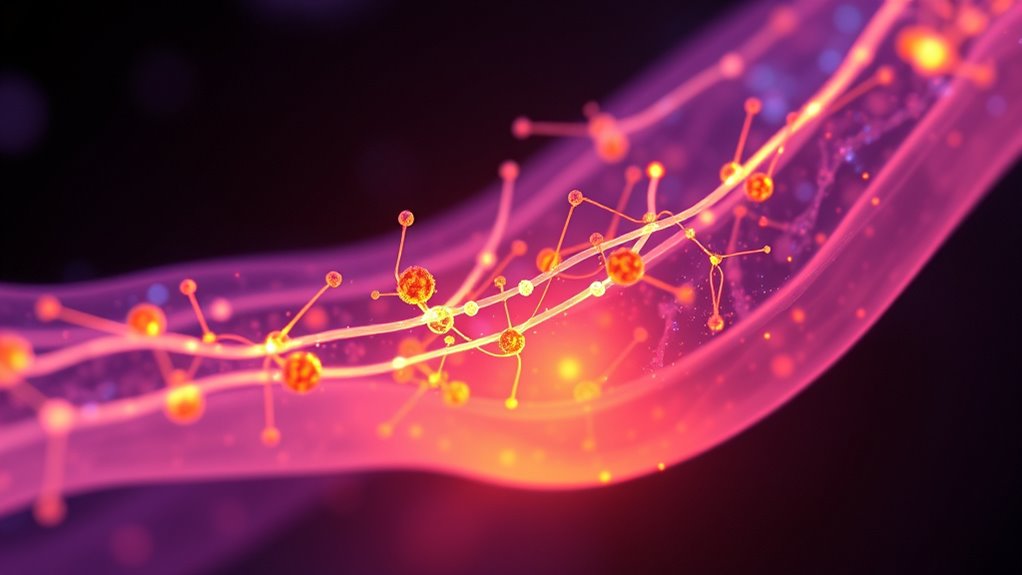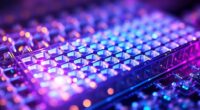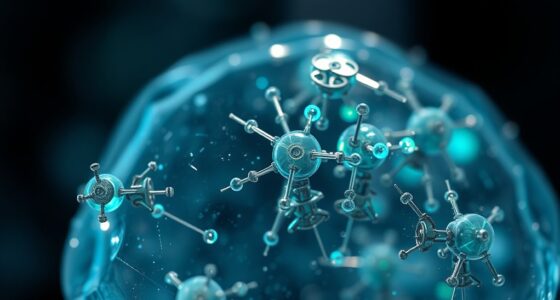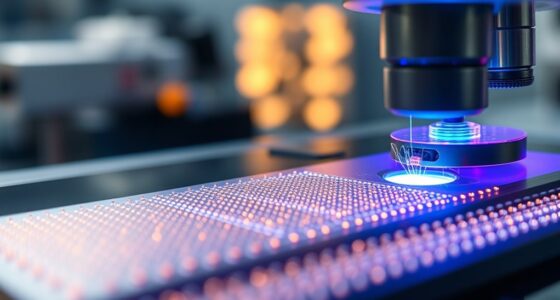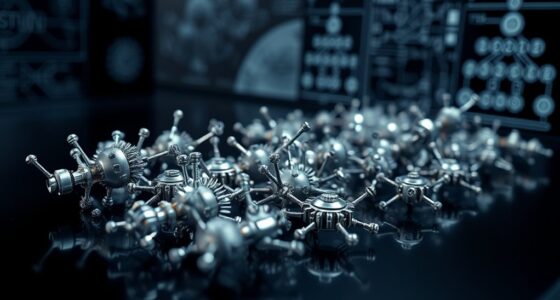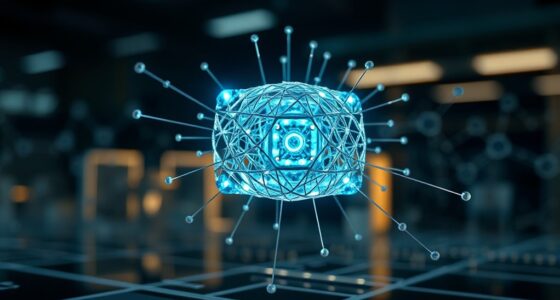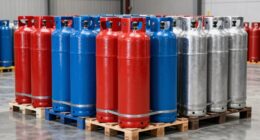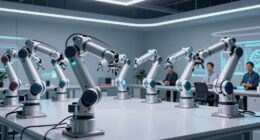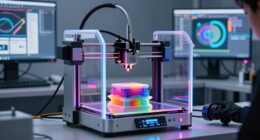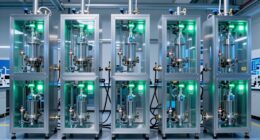Cells harness nanoscale motors, or motor proteins, to move cargo, divide, and generate energy. These tiny machines use ATP to produce movement along structures like microtubules and actin filaments. For example, myosin, kinesin, and dynein transport materials, while ATP synthase produces energy by spinning within membranes. Their incredible efficiency and precision inspire many technological innovations. Keep exploring to discover how these biological nanomachines revolutionize our understanding of life’s microscopic engine.
Key Takeaways
- Cells utilize motor proteins like kinesin, dynein, and myosin to transport cargo along microtubules and actin filaments.
- These nanoscale motors convert ATP energy into mechanical work, enabling movement and cargo delivery within the cell.
- Motor proteins facilitate processes like muscle contraction, organelle positioning, and cell division through directed movement.
- ATP synthase exemplifies a natural rotary nanomachine that synthesizes ATP by converting electrochemical energy into chemical energy.
- Biological nanomachines inspire technological innovations by demonstrating efficient energy conversion and precise nanoscale movement.
The Role of Motor Proteins in Cellular Transport
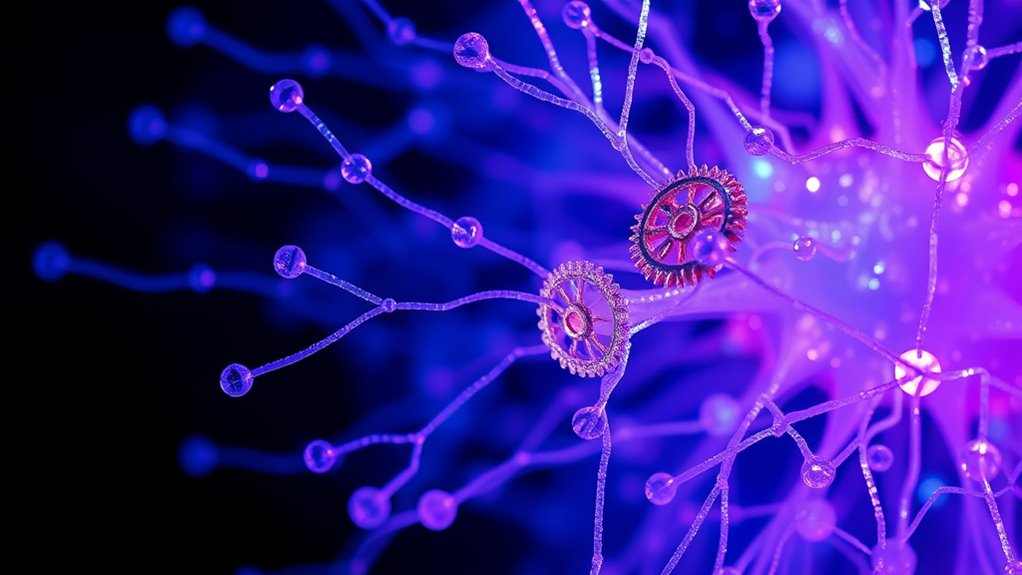
Motor proteins are essential nanomachines that drive the movement of cargo within cells. As you explore cellular transport, you’ll see how these proteins act like tiny vehicles, traveling along the cell’s structural tracks. They use energy from ATP to move, ferrying organelles, vesicles, and other molecules to specific locations. This transportation is crucial for maintaining cell health, enabling processes like nutrient distribution, waste removal, and signal transmission. Your understanding of motor proteins reveals how cells organize their internal environment efficiently. These nanomachines work with remarkable precision, ensuring that each cargo reaches its destination on time. Without them, cells couldn’t coordinate complex activities or sustain life, highlighting their fundamental role in cellular function. High refresh rates and low input lag are characteristics that make some nanoscale motors especially effective at their tasks.
Molecular Machines and Energy Conversion
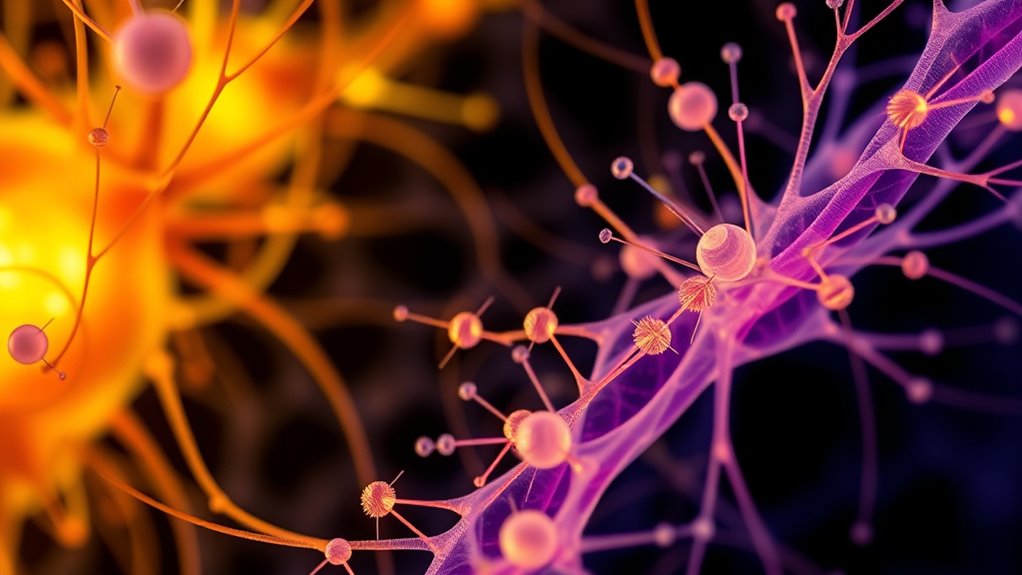
Have you ever wondered how tiny molecules perform complex tasks by converting energy into motion? Molecular machines are specialized nanostructures that do just that. They harness energy from sources like ATP, the cell’s energy currency, to generate movement. For example, ATP binds to these machines, causing conformational changes that produce mechanical work. This energy conversion enables essential processes like muscle contraction, DNA replication, and cell division. These molecular machines are highly efficient, often operating with precision at the nanoscale. Their design involves intricate protein structures that translate chemical energy into mechanical force. By mastering energy conversion at such a small scale, cells can perform a wide range of crucial functions seamlessly. This elegant use of energy underscores the remarkable efficiency of nature’s nanomachines. Understanding these processes reveals just how sophisticated molecular machinery truly is.
How Nanoscale Motors Drive Cell Movement
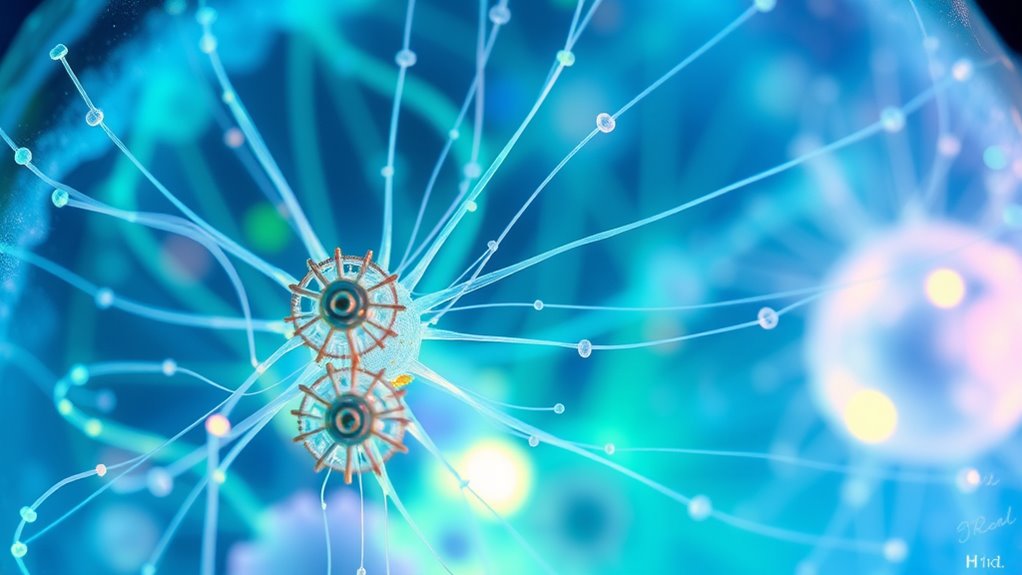
Molecular machines powered by energy conversion are the driving force behind cell movement. These nanoscale motors enable cells to crawl, divide, and respond to their environment. Here’s how they work:
- Myosin pulls along actin filaments, creating contractions that facilitate muscle movement and cell migration.
- Kinesin transports cargo along microtubules, helping position organelles and vesicles.
- Dynein moves in the opposite direction of kinesin, assisting in cell division and organelle positioning.
- Flagellar and ciliary motors generate the whip-like motions that propel single-celled organisms through fluids.
These motors convert chemical energy from ATP into mechanical work, producing directed movement essential for life. Their precise coordination drives complex cellular behaviors seamlessly.
The Structure and Function of ATP Synthase
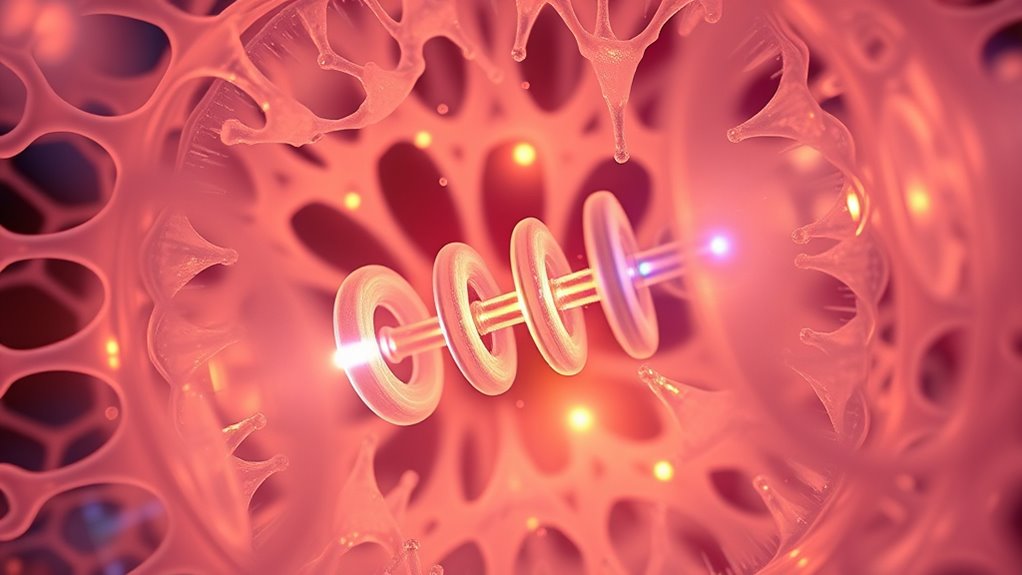
Ever wondered how cells generate the energy they need to perform essential functions? ATP synthase is the nanomachine responsible for this process. It’s a complex enzyme embedded in the cell membrane, with two main parts: the F₀ and F₁ units. The F₀ acts like a turbine, spinning as protons flow through it, driven by the proton gradient created during cellular respiration. This rotation causes a conformational change in the F₁ unit, enabling it to synthesize ATP from ADP and inorganic phosphate. ATP synthase functions like a tiny rotary motor, converting electrochemical energy into chemical energy efficiently. Its precise structure and coordinated motion exemplify nature’s mastery at nanoscale energy conversion, powering nearly every cellular activity that depends on energy. Understanding these nanomachines reveals the incredible complexity and efficiency of biological energy conversion systems.
Insights From Biological Nanomachines for Technology
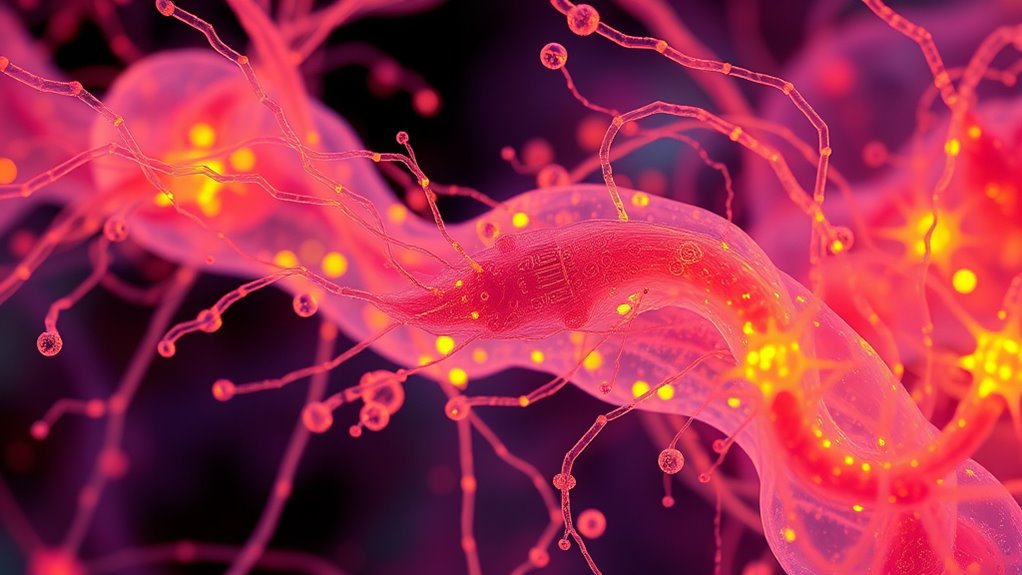
Biological nanomachines like ATP synthase demonstrate remarkable efficiency and precision, inspiring engineers to develop innovative nanotechnologies. You can learn from their mechanisms to improve your designs. For example:
- Mimic the energy conversion processes to create highly efficient energy systems at the nanoscale.
- Use structural insights to develop self-assembling nanostructures with precise functions.
- Apply conformational change principles to design responsive nanodevices that adapt to their environment.
- Incorporate directional movement strategies to improve targeted delivery systems in medicine.
- Gaining a financial literacy understanding of credit card terms can enhance your ability to manage personal finances effectively.
Frequently Asked Questions
How Do Cells Regulate Nanoscale Motor Activity Under Different Conditions?
You can regulate nanoscale motor activity by adjusting motor protein expression levels and modulating their interactions with cellular signals. Cells respond to different conditions by activating or inhibiting specific pathways, which change motor activity accordingly. They also use post-translational modifications, like phosphorylation, to turn motors on or off. Additionally, intracellular calcium levels and energy supply influence motor functions, ensuring proper responses to environmental changes.
What Are the Evolutionary Origins of Cellular Nanomachines?
You might find that cellular nanomachines evolved from ancient proteins that gradually gained specialized functions. Over billions of years, natural selection optimized these proteins into efficient motors, allowing cells to adapt and survive. As organisms became more complex, these nanoscale machines diversified, enabling processes like transport, division, and signaling. This evolutionary journey highlights how simple molecular components transformed into the sophisticated nanomachines that power life today.
Can Nanomachines in Cells Repair Themselves After Damage?
Yes, nanomachines in cells can repair themselves after damage. You see, when damage occurs, cellular nanomachines activate repair mechanisms, repair damaged components, and restore functions. They adapt, rebuild, and recalibrate to maintain efficiency. This self-repair process showcases resilience, flexibility, and ingenuity—allowing life to persist and thrive despite challenges. Your understanding of these tiny yet powerful machines highlights nature’s incredible ability to guarantee survival through self-sustaining, autonomous repair systems.
How Do Nanomotors Coordinate During Complex Cellular Processes?
You observe that nanomotors coordinate during complex cellular processes by working together efficiently within the cell. They communicate through biochemical signals, ensuring that each motor activates at the right time and place. This synchronization allows for precise tasks like transporting cargo, assembling structures, or dividing the cell. The coordination relies on dynamic regulation, feedback mechanisms, and interactions with other cellular components, making the process highly organized and adaptable to changing conditions.
Are There Potential Risks of Harnessing Biological Nanomachines in Medicine?
You should be aware that harnessing biological nanomachines in medicine carries risks like immune responses, unintended interactions, or malfunctioning. These nanoscale systems might trigger unforeseen side effects or toxicity, especially if they behave unpredictably inside the body. While promising, you need careful testing, regulation, and monitoring to guarantee safety, as any failure could cause harm or reduce treatment effectiveness.
Conclusion
You might think natural nanomachines are just tiny biological quirks, but they actually inspire cutting-edge tech. By studying how cells harness these motors, you can see real-world applications like medical nanodevices and energy solutions. Sure, it seems complex, but it’s amazing how nature’s tiny engines work seamlessly. Embracing these biological marvels can lead you to innovative breakthroughs—proof that even the tiniest machines hold huge potential for the future.
